Explore Paro - Bhutan Travel, Asia
Nestled in the heart of the Himalayas, Paro is one of Bhutan’s most charming towns. Known for its deep-rooted history, spiritual landmarks, and breathtaking scenery, this valley town is a top destination for travelers who seek both serenity and adventure. Paro boasts some of Bhutan’s most iconic attractions, including monasteries perched on cliffs, ancient fortresses, and scenic trekking trails. Whether you’re a culture enthusiast, a nature lover, or a spiritual seeker, Paro offers a unique travel experience that blends the old with the new in the most captivating way.
Population: Approximately 35,000 in 2021.
Economy: Paro's economy is mostly based on tourism, agriculture, and small-scale industries. The town benefits from its cultural landmarks, attracting visitors and boosting local hospitality and handicrafts.
Landmarks: Famous for the Tiger’s Nest Monastery (or Paro Taktsang), Rinpung Dzong, and the Kyichu Lhakhang.
Bhutan
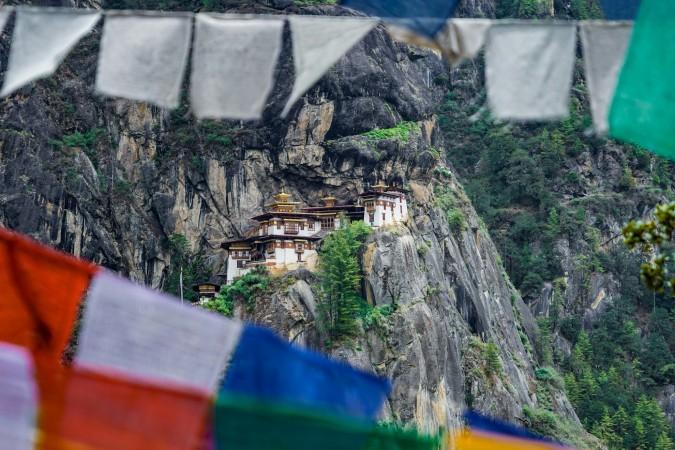
Overview of Paro
History & Culture Influence
Paro is steeped in history and tradition, making it one of Bhutan's cultural gems. The town holds a special place in the country’s past, with influences from Buddhism shaping its identity for centuries. As you explore Paro, you’ll encounter dzongs (fortresses) and lhakhangs (temples) that have stood the test of time, preserving Bhutan’s spiritual essence. Buddhism plays a central role in Paro’s cultural identity, with many spiritual sites drawing visitors from around the world. Among them, the most famous and must-see spiritual site is Kyichu Lhakhang, one of Bhutan's oldest temples and a symbol of the town's religious legacy.
Interaction with the Locals
Paro is a small valley town with a population consisting primarily of Bhutanese origin, known for their warmth and hospitality. The majority of the population follows Tibetan Buddhism, which strongly influences their daily lives and cultural practices. The people of Paro live in harmony with nature, and many are engaged in agriculture, small businesses, and tourism-related activities. Despite modern developments, Paro’s citizens maintain their rich traditions, making the town a charming blend of the past and present.
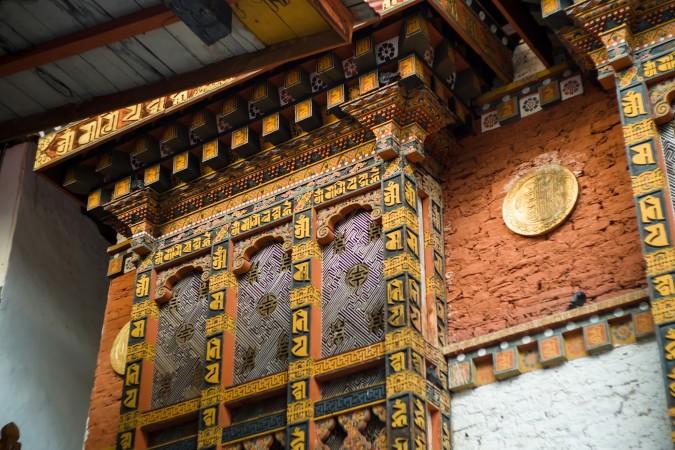
Inside Rinpung Dzong - © Raimond Klavins
Top Attractions in Paro
Paro is a treasure trove of cultural, spiritual, and historical landmarks that captivate travelers from around the world. Each attraction is a must-visit site in Bhutan that offers a unique glimpse into Bhutan’s rich heritage and natural beauty.
Tiger’s Nest Monastery (Paro Taktsang)
The Tiger’s Nest Monastery is undoubtedly the most iconic and breathtaking site in Paro. Perched on a cliffside 3,120 meters above sea level, this sacred monastery is one of Bhutan’s holiest sites. According to legend, Guru Rinpoche flew to this location on the back of a tigress, bringing Buddhism to Bhutan. The trek to the monastery is a pleasant experience with breathtaking views of the Paro Valley below. The spiritual energy and the awe-inspiring scenery make this a once-in-a-lifetime experience for many travelers.
Rinpung Dzong
Another highlight of Paro is Rinpung Dzong, which means "Fortress of the Heap of Jewels." This architectural masterpiece is a symbol of Bhutan’s unique fortress-monastery style, with its towering whitewashed walls and intricate wood carvings. Visitors can explore the dzong’s courtyards and learn about its historical significance as both a religious and administrative center. During the annual Paro Tsechu, the dzong becomes the heart of the festival, where locals and tourists gather to witness colorful mask dances and religious rituals.
Kyichu Lhakhang
One of Bhutan’s oldest and most revered temples, Kyichu Lhakhang, offers a tranquil retreat for those seeking a spiritual experience. Built in the 7th century, this temple is believed to be one of 108 temples constructed by Tibetan King Songtsen Gampo to subdue a demoness across the Himalayan region. Visitors can walk around the temple, turning prayer wheels and soaking in the peaceful atmosphere. Kyichu Lhakhang is a calm reminder of Bhutan's ancient spiritual roots that provides a peaceful respite from the hustle and bustle of daily life.
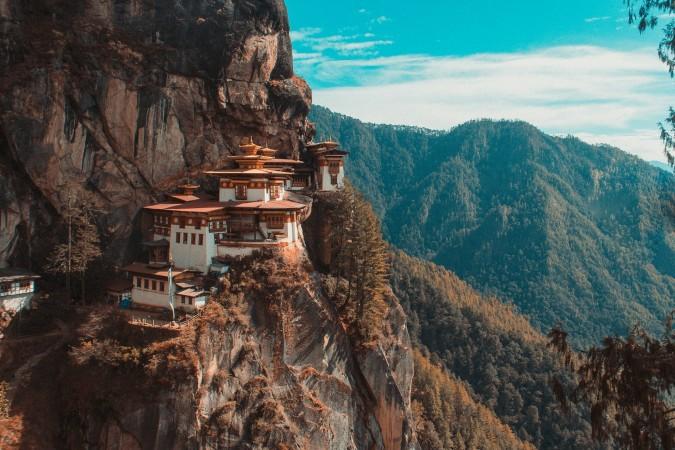
Tiger’s Nest Monastery (Paro Taktsang) - © Aaron Santelices
Must-Try Dishes in Paro
Paro is a foodie's dream, offering a one-of-a-kind and savory journey into Bhutanese cuisine. Local dishes are known for their bold use of chilies and cheese, offering a taste adventure that is as rich in flavor as it is in tradition.
- Ema Datshi: As Bhutan’s national dish, Ema Datshi is a staple you cannot miss. Made from spicy green chilies and local cheese, this dish is a fiery and creamy delight, usually served with red rice. The combination of heat from the chilies and the rich texture of the cheese creates a flavor profile unlike any other.
- Phaksha Paa: Phaksha Paa is a hearty dish made of sliced pork stir-fried with dried red chilies, radishes, and sometimes spinach. The flavors of the dried chilies combined with tender pork make this a savory favorite for meat lovers. It's a perfect example of Bhutanese comfort food.
- Jasha Maru: For those who prefer chicken, Jasha Maru is a must-try. This dish consists of diced chicken cooked with tomatoes, garlic, ginger, and chilies. Slightly less spicy than Ema Datshi, it offers a flavorful blend of fresh ingredients, often served with rice and vegetables.
- Hoentay: Hoentay are buckwheat dumplings packed with spinach, cheese, and turnip greens, making them a distinct Haa Valley specialty. These dumplings are steamed and served with a chili sauce, offering a healthy and delicious alternative to the traditional flour-based Momos.
- Goep: For adventurous eaters, Goep (tripe) is a local delicacy. Cooked with onions, tomatoes, and chilies, it has a unique texture and rich flavor. This dish is usually stir-fried and often enjoyed by locals who appreciate the bold, spicy flavors of Bhutanese cuisine.
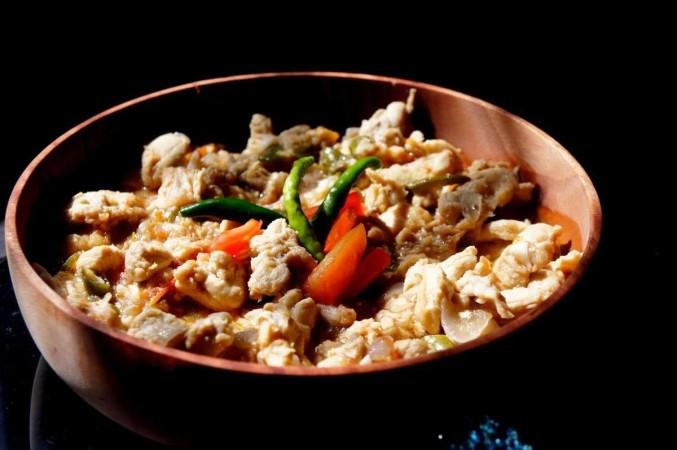
Jasha Maru - © Thomas Cook
Festivals & Local Celebrations
Paro is renowned for its vibrant festivals and religious celebrations, deeply rooted in Bhutanese Buddhist traditions. These events offer visitors a unique opportunity to witness colorful rituals, traditional dances, and the deep spiritual connection of the Bhutanese people.
Paro Tshechu Festival
The most famous event in Paro is the Paro Tshechu. Taking place every spring at the iconic Rinpung Dzong, this multi-day festival attracts both locals and tourists, who come to witness spectacular mask dances and religious rituals performed by monks. The highlight of the festival is the unfurling of the giant thangka (religious painting) known as the Thongdrel, which is displayed on the last day of the celebration, offering blessings to those who view it. This colorful and spiritual festival is a must-attend for anyone visiting Paro during this period.
Chotrul Duchen
Chotrul Duchen, or the Day of Miracles, is another significant celebration in Bhutan. It commemorates the 15-day battle of miracles between Buddha and his opponents, showcasing Buddha's victory through supernatural abilities. In Paro, locals gather at monasteries and temples to offer prayers, light butter lamps, and take part in religious ceremonies. The festival is a great opportunity for visitors to witness Bhutanese devotion and spirituality in a more intimate setting.
Lhabab Duchen
Lhabab Duchen is a religious festival that celebrates the descent of Buddha from heaven to earth. The event takes place in various monasteries across Bhutan, including those in Paro. Monks and laypeople gather to offer prayers and perform rituals that honor Buddha’s teachings and his return to earth to spread the Dharma. It’s a deeply spiritual festival, and visitors can observe traditional rituals, prayer offerings, and butter lamp lighting during this time.
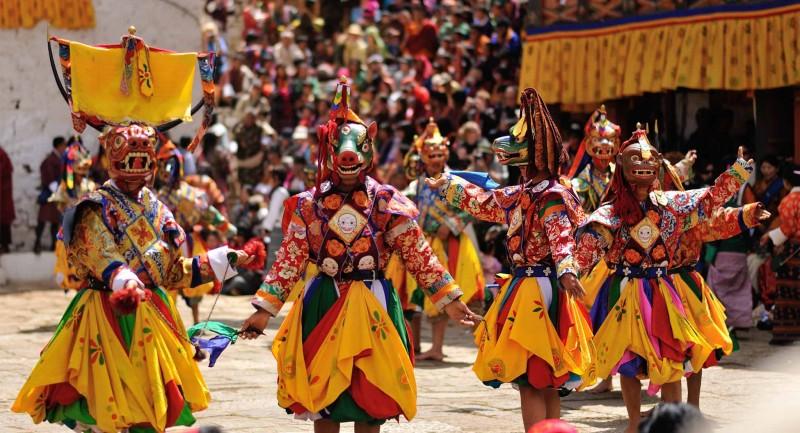
Paro Tshechu Festival - © Bhutan Tourism
What to Do in Paro
- Trekking trails in Paro: The lush landscapes around Paro are perfect for hiking and trekking. The most popular hike is the Tiger’s Nest trek, a half-day journey that takes you up to the famed Taktsang Monastery perched on a cliff. For those looking for longer trails, Druk Path Trek is a multi-day trek that connects Paro to Thimphu, passing through ancient monasteries, high-altitude lakes, and stunning mountain views.
- Meditation and Spiritual Retreats: Paro is home to numerous monasteries and temples, offering travelers the chance to participate in meditation and spiritual retreats. Many visitors come to Kyichu Lhakhang or Dzongs for a quiet moment of reflection. Some monasteries also offer short meditation programs where travelers can experience Bhutanese spirituality firsthand.
- River Rafting and Archery: For thrill-seekers, river rafting along the Paro Chhu River offers an exciting way to take in the natural beauty of the valley. If you prefer to experience Bhutan’s national sport, you can try archery at local facilities. Bhutanese archery is a unique and lively experience, often accompanied by singing and cheering from the participants.
Shopping in Paro
- Handicrafts and Textiles Stores: One of the most popular souvenirs from Paro is Bhutanese handicrafts, including intricate wood carvings, handmade thangkas (Buddhist paintings), and vibrant textiles. The traditional kira and gho, Bhutan’s national dress, are beautifully woven from silk and cotton, making them sought-after items for visitors.
- Paro Markets: The Paro Town Market is a bustling hub where you can buy a variety of local goods, from yak wool scarves to prayer flags. These markets are perfect for picking up souvenirs that are both meaningful and unique to Bhutanese culture. The vendors are friendly, and bargaining is often a part of the shopping experience.
- Thangka Paintings Specialty Stores: For a special keepsake, consider purchasing a thangka painting, a traditional Buddhist art form. These sacred paintings depict deities, mandalas, and religious symbols, and are often hand-painted by local artisans. Owning one is not just a beautiful decoration but a meaningful connection to Bhutan’s spiritual traditions.
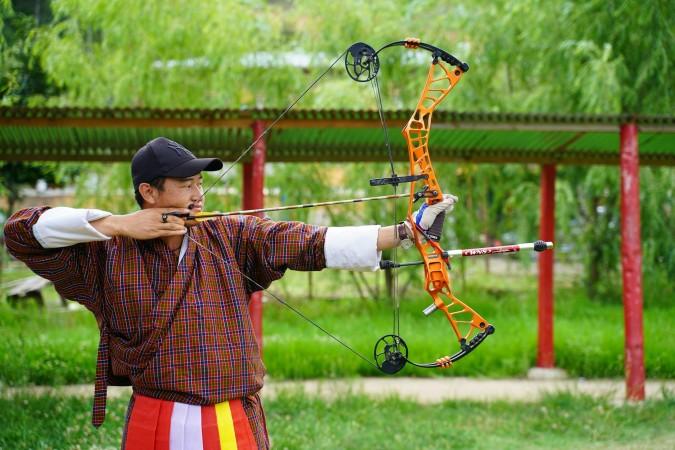
Practicing archery with the Bhutanese in Paro - © nimrod sheinman
Weather in Paro: Best Time to Visit
Paro experiences a varied climate throughout the year, making it essential for travelers to plan according to their preferences for weather and activities. The valley enjoys four distinct seasons, each offering its unique charm.
Spring in Paro
Spring is one of the best times to visit Paro when the weather is mild and temperatures range between 8°C to 20°C (46°F to 68°F). This season is ideal for exploring Paro’s beautiful landscapes as the valley comes alive with blooming rhododendrons, cherry blossoms, and colorful wildflowers. Spring is also a popular time for trekking, especially to iconic spots like Tiger’s Nest Monastery.
Summer in Paro
Summer in Paro brings the monsoon season, with frequent rains and temperatures between 15°C to 25°C (59°F to 77°F). While the rains make the valley lush and green, the monsoons can also make trekking difficult due to muddy paths. However, if you don’t mind occasional showers, this is a quieter time to visit with fewer crowds and the opportunity to witness the landscape at its most vibrant.
Autumn in Paro
Autumn is another peak season for tourism in Paro. The weather is crisp and clear, with temperatures ranging from 10°C to 23°C (50°F to 73°F), ideal for outdoor activities such as hiking and visiting festivals like the Paro Tsechu. The skies are usually bright blue, and the air is fresh, offering stunning views of the Himalayan mountains.
Winter in Paro
Winter in Paro is cold, with temperatures often dropping to -5°C (23°F) at night, while daytime temperatures hover around 10°C (50°F). Snow is common in higher altitudes, but Paro Valley itself rarely experiences heavy snowfall. Winter is ideal for those seeking solitude, as tourist numbers drop significantly, and the crisp air adds a magical touch to the town’s monasteries and dzongs.
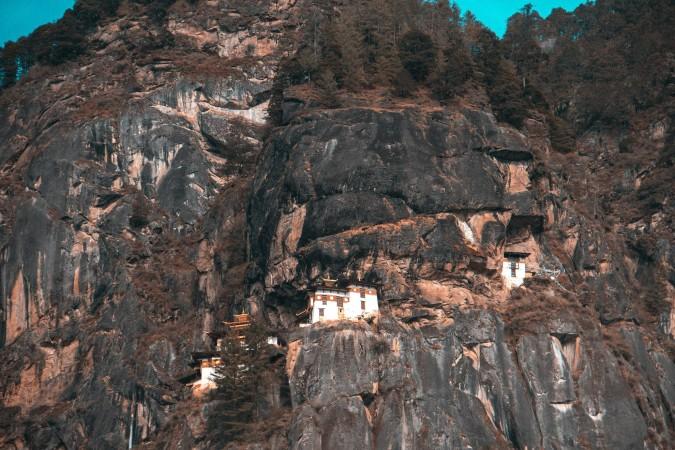
Experience the Tiger’s Nest trekking trail - © Aaron Santelices
Essential Travel Information
Getting Around Paro
- Taxis: Taxis are readily available in Paro and provide a convenient way to travel within the town and to nearby attractions. While taxis don’t use meters, it’s standard practice to agree on a fare with the driver before setting off.
- Car Rentals: For those who prefer more flexibility, car rentals are an optimal option. However, renting a vehicle with a driver is a much preferred choice for navigating Bhutan’s winding mountain roads. Hiring a driver familiar with the area ensures a smoother and safer journey, especially for trips to remote sites or between towns.
- Walking: Paro is a small, walkable town, and many of the main attractions, including local markets and dzongs, are easily accessible on foot. Walking around the town also provides an opportunity to engage with locals and experience Paro’s charm at a leisurely pace.
ATM & Banking Services
When visiting Paro, it's important to plan ahead for banking and cash needs, as ATMs and card payment options may be limited in some areas. While ATMs are available in the town center and near the airport, not all international cards are accepted, so it's advisable to carry enough cash in Bhutanese Ngultrum (BTN). Currency exchange services can be found at the airport, larger hotels, and in the capital, but it's best to have local currency on hand, especially when visiting rural areas.
Where to Stay in Paro
- Luxury Resorts: For travelers seeking a high-end experience, Paro has several luxury resorts that blend modern comforts with traditional Bhutanese design. These resorts typically offer amenities such as spa services, fine dining, and guided tours of the valley’s key attractions. With beautiful views of the surrounding mountains and rivers, they provide a serene and indulgent retreat for guests looking to relax in style.
- Mid-Range Hotels: If you're looking for a comfortable stay without breaking the bank, mid-range hotels in Paro provide a great balance of affordability and convenience. These hotels offer cozy rooms, often featuring Bhutanese décor, and are located close to major attractions like temples and museums.
- Budget Guesthouses and Homestays: For those on a tighter budget or looking for a more authentic experience, guesthouses and homestays are excellent choices. These accommodations provide basic amenities, and staying in a homestay allows you to live with a local family, offering a unique opportunity to experience Bhutanese culture up close.
Articles for you

Explore Yala National Park - Sri Lanka Travel, Asia
Tucked away in Sri Lanka’s southeastern corner, Yala National Park is where wild nature meets deep tradition. Known worldwide for its leopard population, the park is also home to elephants, sloth bears, crocodiles, and hundreds of bird species. Beyond wildlife, Yala opens doors to a cultural landscape dotted with ancient temples, Buddhist ruins, and coastal villages. For travelers seeking more than just a safari, Yala offers a chance to explore eco-tourism, local communities, and sacred heritage sites.
Population: The Yala National Park area doesn’t have a human population.
Economy: The economy around Yala National Park thrives on a blend of eco-tourism, agriculture, and local services. Safari tours, eco-lodges, and cultural experiences drive steady income for nearby towns like Tissamaharama and Kataragama, supporting thousands of families.
Landmarks: Famous for Block I of Yala and wildlife encounters, including elephants, sloth bears, crocodiles, and exotic bird species.

Explore Galle - Sri Lanka Travel, Asia
Nestled on Sri Lanka’s southern coastline, Galle is a vibrant city where history meets the sea. Its cobbled streets, colonial architecture, and serene beaches make it a must-visit destination for travelers seeking a blend of culture, adventure, and relaxation. A UNESCO World Heritage site, Galle captivates visitors with its Dutch Fort, bustling markets, and friendly locals. Whether you’re exploring the ramparts at sunset or savoring fresh seafood by the shore, Galle promises an unforgettable journey into Sri Lanka’s heritage.
Population: Approximately 113,000 in 2023.
Economy: Galle’s economy thrives on tourism, trade, and fisheries. The city’s historic fort, colonial architecture, and coastal charm draw thousands of international visitors each year, making tourism its main economic driver. Fishing remains vital for local livelihoods, supplying fresh seafood across the region.
Landmarks: Famous for the Galle Fort, Dutch Reformed Church & Maritime Museum, and Unawatuna Beach.

Explore Bentota - Sri Lanka Travel, Asia
Nestled along Sri Lanka’s southwestern coast, Bentota is a tropical paradise that blends golden beaches, vibrant culture, and thrilling adventures. Famous for its calm waters, luxury resorts, and scenic river estuary, Bentota has become a top destination for travelers seeking both relaxation and authentic experiences. From serene beach walks at sunrise to adrenaline-pumping water sports, this coastal town offers a perfect balance of leisure and exploration. With its proximity to Colombo and Galle, Bentota is easy to reach, making it an ideal stop for both short escapes and extended holidays.
Population: Approximately 37,000 in 2023.
Economy: Bentota’s economy thrives mainly on tourism, which drives local businesses such as hotels, restaurants, and wellness retreats. The town also benefits from fishing, coconut cultivation, and handicrafts like wood carving and batik textiles. Many residents rely on the growing demand for water sports and Ayurvedic treatments, making tourism the backbone of both income and employment in the area.
Landmarks: Famous for Bentota Beach, Bentota River Safari, and Kande Vihara Temple.

Explore Mirissa - Sri Lanka Travel, Asia
Mirissa is a charming coastal town on Sri Lanka’s southern shoreline. Known for its golden beaches, turquoise waters, and vibrant marine life, it has become a must-visit stop for travelers exploring the island. Many come for whale watching, surfing, and sunset views at Coconut Tree Hill, but Mirissa offers much more than postcard beauty. The fishing boats you see anchored by the bay carry generations of stories. Local traditions, delicious cuisine, and a laid-back rhythm of life shape every visitor’s experience.
Population: Approximately 4,700 in 2023.
Economy: Mirissa’s economy is largely shaped by its coastal location. Fishing has long been the backbone of local livelihoods, with generations relying on the Indian Ocean for income. In recent decades, tourism has become the main driver of growth, thanks to whale watching, surfing, and beachside hospitality.
Landmarks: Famous for Mirissa Beach, Coconut Tree Hill, and Parrot Rock Bridge.

Explore Nuwara Eliya - Sri Lanka Travel, Asia
Tucked away in the Central Highlands of Sri Lanka, Nuwara Eliya is often called “Little England”. With its rolling tea plantations, cool misty mornings, and colonial charm, this mountain town feels like a step into another world. Travelers come here to breathe fresh air, walk through flower gardens, sip the finest Ceylon Tea, and enjoy a pace of life far from the island’s busy cities. Whether you’re drawn by scenic landscapes, heritage architecture, or the warmth of its people, Nuwara Eliya is a destination that blends nature, culture, and history in perfect harmony.
Population: Approximately 781,000 in 2023.
Economy: Nuwara Eliya’s economy thrives mainly on tea production, as it sits in the heart of Sri Lanka’s central highlands, famous worldwide for Ceylon Tea. The city also benefits from a growing tourism industry, attracting visitors with its colonial charm, cool climate, and scenic landscapes.
Landmarks: Famous for Gregory Lake, Hakgala Botanical Garden, and Victoria Park.

Explore Sukau - Malaysia Travel, Asia
Nestled on the banks of the Kinabatangan River in Sabah, Malaysian Borneo, Sukau is a destination where wildlife, culture, and conservation come together. Known as one of Asia’s top spots for river safaris and eco-tourism, this quiet village offers a front-row seat to encounters with Bornean orangutans, pygmy elephants, proboscis monkeys, and exotic birdlife.
Population: Approximately 1,400 in 2019.
Economy: Sukau’s economy is shaped by its riverine location and natural resources. Traditionally, the Orang Sungai community relied on fishing, small-scale farming, and forest gathering for their livelihood. Today, the village has shifted toward eco-tourism, with river cruises, jungle trekking, and homestays providing income.
Landmarks: Famous for the Kinabatangan River cruises, Gomantong Caves, and Ox-bow lakes and wetlands.
